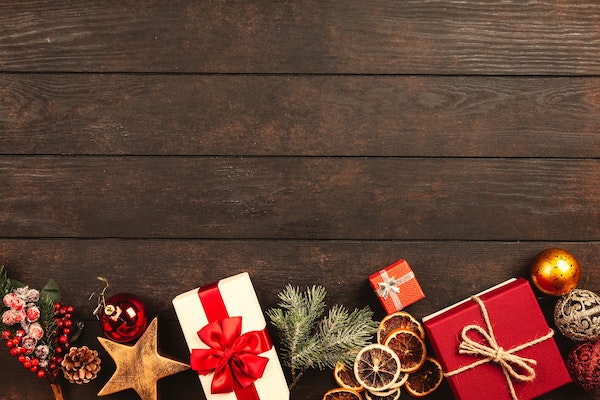This guest blog has been written by Hurst Rethink member James Griswood.
The Season of Waste
Around 114,000 tonnes of plastic packaging will be thrown away in the UK this Christmas – that’s equivalent to the weight of 3.3 Million Emperor penguins! Add that to the 300,000 tonnes of card packaging equivalent to 2 million reindeer (source – WRAP) and you start to get an idea as to the amount of stuff we throw away each Christmas. Don’t forget the wrapping paper – around 88 square km (source – DEFRA) , which is enough to gift wrap the Brighton & Hove, Worthing and Littlehampton areas. Now, I’m not suggesting we unwrap Brighton and fill it full of penguins and reindeer, but these statistics do help visualise how much waste an average Christmas generates.
How To Enjoy Christmas Sustainably
We all know that living sustainably and reducing our carbon footprint is important if we are to combat climate change: It is something that needs to be woven into our day-to-day choices. That’s why at Hurst Rethink we are working to help deliver sustainable change in the villages of Hurstpierpoint and Sayers Common. With Christmas approaching, we thought we would share some tips to enjoying a sustainable and low-carbon Christmas.
Making minor changes to our Christmas plans over the next few weeks can have an important influence on our annual impact. We spend a third more in December than in a typical month (source – Bank of England), and the average person spends £1,116, with £381.60 going on presents alone (source – YouGov) . If we could each try and move our additional festive spending to more sustainable, locally sourced or ethically produced products, we could have a massive impact on our annual carbon footprint. Here are three key areas to minimise your environmental impact this Christmas.

1. Christmas Tree & Decorations
According to the Carbon Trust, a real Christmas tree has a lower carbon footprint than an artificial tree, particularly if locally grown and properly disposed of. Many artificial trees are produced in China and contain non-recyclable plastics. If you already own an artificial tree, then use it for as many years as possible to reduce its total lifetime carbon footprint.
If you’re after a real tree this year, why not head to Fox Hill Christmas Trees in Haywards Heath or Sussex Trees in Lindfield for a locally grown tree. If you do use a real tree it’s essential that it is disposed of correctly via the local council recycling scheme. This ensures it will be shredded and composted rather than buried.
When decorating your house and tree, why not try to use natural or sustainable items. Tinsel and glitter-covered decorations all tend to contain micro plastics. Head outdoors and use carefully foraged materials for decorations and to make a natural Christmas wreath. It’s the perfect excuse to get the kids outdoors. For foodies, why not try your hands at making edible decorations.
2. Cards & Wrapping
An unbelievable 1.5 Billion Christmas cards are thrown away by UK households each year. (source – Imperial College research) – that’s the equivalent of around 30 million trees. Add in the envelopes, box and plastic wrap that they often are sold in and that’s a lot of rubbish. So, what are the alternatives? The obvious answer is an e-card, which cuts out all of these consumables. Send one via Friends of the Earth and add a donation in lieu of a gift. However, if you are going to send a real card then make sure it’s made from recycled paper, preferable with FSC accreditation. Look for ones without glitter, plastic or other non-paper decorations on them which adds difficulty for recycling.
Wrapping paper is another concern. Lots of wrapping paper contains plastic which along with sticky tape and ribbons tend not to be recyclable. If you do buy wrapping paper, buy those made from recycled paper, that use environmentally friendly inks and from a carbon-balanced manufacturing process such as these. Alternatively, the understated elegance of brown parcel paper tied up with string can make a present really stand out.
Why not cut out single-use wrapping completely and wrap your presents with Furoshiki cloth. This is a Japanese art of wrapping goods for transport. By using a beautifully-designed reusable cloth, the wrapping becomes as much a present as what’s inside. Either buy the fabric or why not dye some fabric yourself for a truly unique wrapping. There are plenty of Youtube videos showing how it is done.
3. Festive Food
Did you know that if it were a country, food waste would be the third highest emitter of greenhouse gasses in the world (source – FAO 2011). Christmas is a notoriously gluttonous period, which has correspondingly high food waste figures. It is estimated that 4.2 million Christmas dinners are wasted in the UK (source – Unilever) – that’s about 260,000 turkeys!
The key to reducing our food waste over Christmas is planning and not buying too much to start with. Use a portion planner like this one to get it right from the start. However, Christmas leftovers are sometimes the best bits! Coming up with interesting recipes other than turkey sandwiches is often the key to using up the random bits in the fridge. If you’re stuck for ideas, BBC Good Food has a long list of Christmas leftover recipes.
You can also help to make your Christmas more sustainable by buying locally, choosing organic or low food-miles produce. We’re blessed in Hurst to have access to a local independent butcher, grocer and delicatessen who can provide locally sourced produce. Don’t forget to go local with the Christmas booze too. We’re surrounded by some amazing English wineries, so enjoy a glass of English fizz rather than Champagne this Christmas.
Have you got any tips for a less wasteful Christmas? If so, let us know!
